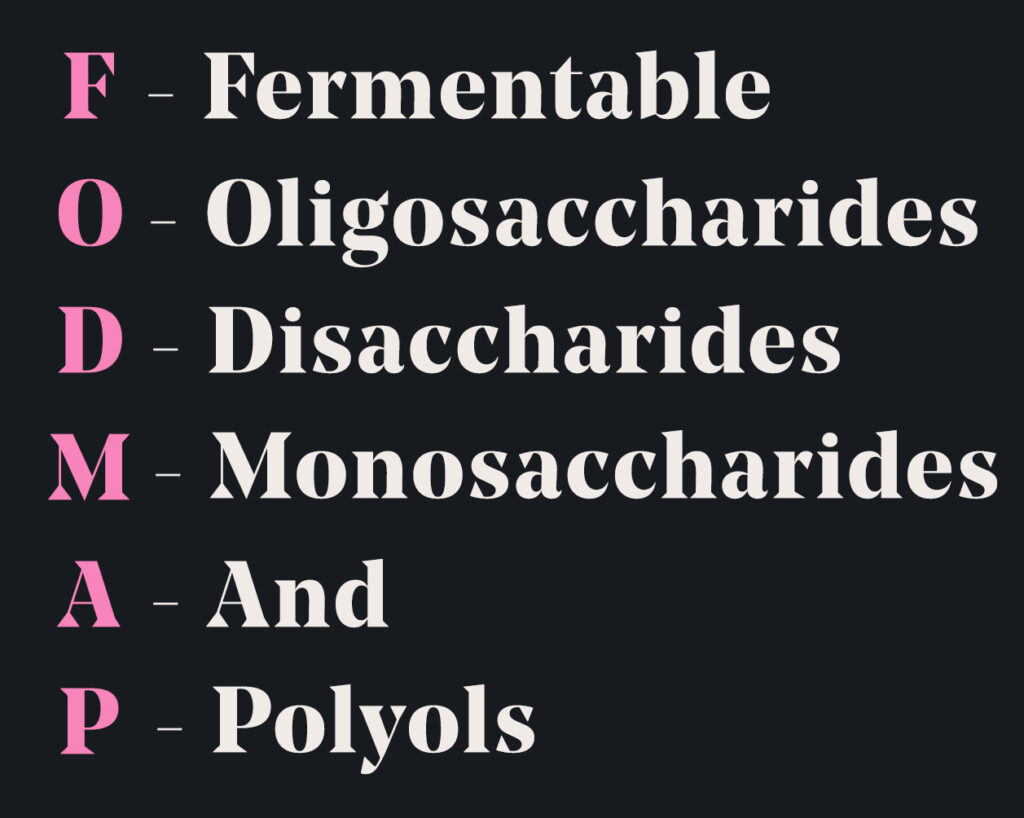
Being a FODMAP friendly brand is the latest trend amongst health fanatics, also being a necessity diet for those that suffer with IBS.
In June 2005 a professor from Australia discovered through a clinical trial that leading a low FODMAP diet could cure sufferers from bowel issues, including symptoms like bloating and abdominal pain.
 We bet you are thinking, “What does this all mean?
We bet you are thinking, “What does this all mean?
Well, we have broken it down for you even more…
Fermentable – the act of a group of organisms which ferment in the digestive system
Oligosaccharides – “oligo” means “few” and “saccharide” means “sugar” link of individual sugar molecules joined together in a chain
Disaccharides – “di” means two, therefore this is a double sugar molecule
Monosaccharides – “mono” means single therefore this a single sugar molecule
And
Polyols – sugar alcohols
To summarise…
FODMAPs are a collection of short chain carbohydrates and sugar alcohols that occur naturally in certain foods.
FODMAPs include fructose (when in excess of glucose), Fructans, Galacto-oligosaccharides (GOS), Lactose and Polyols (e.g. Sorbitol and Mannitol).
If these sugars are poorly digested they start to ferment in the lower part of your large intestine. Thus, causing problems for those of you which suffer from IBS.
BRANDS PAY ATTENTION!
This is how you can make yourselves become FODMAP friendly.
First of all, make your clientele understand what FODMAPs are (many that have bowel problems should already know about FODMAPs).
However, only 17% of consumers know what a FODMAP is – whether this is because it’s a confusing subject area or there’s not a lot of publicity of FODMAP friendly foods we’re not sure, but education is key.
Secondly, you need to understand which foods are high in FODMAPs.
Here are the top 5 foods that are high on the FODMAP scale:
- Wheat (Pasta/Bread/Biscuits)
Wheat can be swapped for items of food such as brown rice, buckwheat, oats and quinoa.
- Garlic (restricting garlic can be very difficult as it is in the majority of foods)
Fructans are the main type of FODMAP in garlic, a low-FODMAP ingredient swap would be chives, chilli or ginger. Get your consumers taste buds tingling!
- Onion
Shallots have the highest amount of fructan and Spanish white onions have the lowest amount. Whereas different varieties of onions contain different amounts of FODMAPS all onions are considered a high-FODMAP.
Swap onion for Asafoetida, this is a pungent spice which is commonly used in Indian cooking. It is a great onion substitute!
- Fruits
Apples/Apricots/Cherries/Figs/Mangoes/Nectarines/Peaches/Pears/Plums
- Vegetables
Asparagus/Cauliflower/Leeks/Mushrooms/Brussel Sprouts
Avoid using these foods in your products if you can!
Finally, which foods are low on the FODMAP scale?
- Protein: Beef, chicken, eggs, fish, lamb, pork, prawns and tofu
- Whole grains: Brown rice, buckwheat, maize, millet, oats and quinoa
- Fruit: Bananas, blueberries, kiwi, limes, mandarins, oranges, papaya, pineapple, rhubarb and strawberries
- Vegetables: Bean sprouts, bell peppers, carrots, aubergine, kale, tomatoes, and spinach
- Nuts: Almonds (no more than 10 per sitting), macadamia nuts, peanuts, pecans, pine nuts and walnuts
- Seeds: Linseeds, pumpkin, sesame and sunflower
- Dairy: Cheddar cheese, lactose-free milk and Parmesan cheese
- Oils: Coconut oil and olive oil
- Beverages: Black tea, coffee, green tea, peppermint tea, water and white tea
- Condiments: Basil, chilli, ginger, mustard, pepper, salt, white rice vinegar and wasabi powder
Basically, ditch the high-FODMAP ingredients and use low-FODMAP ingredients to your hearts content! Then you’re sure to be on your way to becoming a FODMAP friendly brand.
